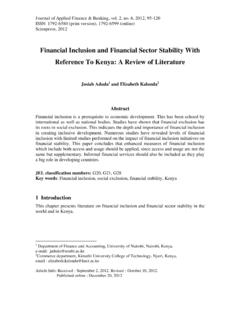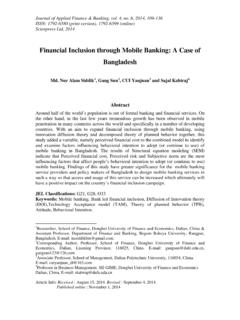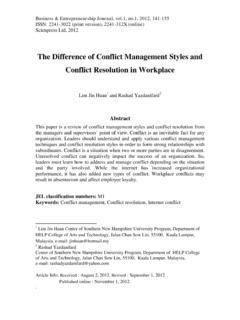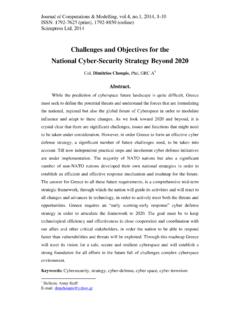Transcription of EGARCH, GJR-GARCH, TGARCH, AVGARCH, NGARCH, IGARCH …
1 Journal of Statistical and Econometric Methods, vol. 2, , 2013, 57-73 ISSN: 2051-5057 (print version), 2051-5065(online) Scienpress Ltd, 2013 EGARCH, GJR-GARCH, TGARCH, AVGARCH, NGARCH, IGARCH and APARCH Models for Pathogens at Marine Recreational Sites Ghulam Ali1 Abstract The environmental literature lacks the use of volatility based models for environmental stochastic processes. To overcome this deficiency, we use EGARCH, IGARCH , TGARCH, GJR-GARCH, NGARCH, AVGARCH and APARCH models for functional relationships of the pathogen indicators time series for recreational activates at beaches. We use generalized error, Student s t, exponential, normal and normal inverse Gaussian distributions along with their skewed versions to model pathogen indicator time series.
2 Generally speaking, turbidity, rainfall, dew point, river flow and cloud cover are significant variables. EGARCH, TGARCH, NAGARCH and AVGARCH are not radically different from each other in their output. However, TGARCH could be marginally better than the rest of models in capturing response of the pathogen indicator variable. Evidence supports some sign bias effect of the shocks. Dry weather and wet weather conditions of the same magnitude seem to have disproportionate effect on pathogens. Nyblom test shows that the estimated parameters are stable. Mathematics Subject Classification: 62H12, 62M10, 62P10, 62P12. Keywords: TGARCH, GJR GARCH, EGARCH, APARCH, Generalized Error Distribution, Student s t, normal, pathogen indicators, Huntington Beach.
3 1 Introduction Response variables are not only affected by exogenous variables but also by themselves from their past behavior. On the basis of this theoretical underpinning, autoregressive models have been invented. Box and Jenkins time series modeling is indispensable in 1 Economist, United States Environmental Protection Agency, Office of Water, Office of Science and Technology, Standards and Health Protection Division, 1200 Pennsylvania Avenue, NW, Washington, DC. 20460, USA. The views expressed herein are those of the author and may not be attributed to the organization of his employment or anyone else associated with it, in any way. Article Info: Received : May 11, 2013.
4 Revised : June 9, 2013. Published online : September 9, 2013 EGARCH, GJR-GARCH, TGARCH and AVGARCH Models 58 analyzing stochastic processes. Autoregressive and moving average models are used frequently by many disciplines. In environmental science, they have been rarely, if ever, used in reference to the autoregressive variance and the mean of the distribution. What are even rarer in use are the various forms of the specification of the error terms in the estimation of the autoregressive models. Typically, normal distribution is used for the error terms of the stochastic equation; it is a mainstay of the environmental econometrics.
5 The autoregressive framework is used in macroeconomics, such as for money supply, interest rate, price, inflation, exchange rates and gross domestic product. The autoregressive heteroscedastic modeling framework is used in financial economics, such as asset pricing, portfolio selection, option pricing, and hedging and risk management. There are a number of studies in the financial literature about modeling the return on stocks. Usually, in the financial market, upward movements in stock prices are followed by lower volatilities, while negative movements of the same magnitude are followed by much higher volatilities. Engle [1] developed the time varying variance model. Bollerslev [2] extended the model to include the ARMA structure.
6 Since then, a number of studies have adopted the autoregressive conditional heteroscedastic (ARCH) or a generalized autoregressive conditional heteroscedastic (GARCH) framework to explain volatility of the stock market. Bad and good news both seem to increase the volatility of the stock market. Large changes follow the large changes and smaller changes follow the small changes in the stock market. Negative shocks have a much larger effect on stock pricing than positive shocks of the same magnitude. The negative shock has a long lasting impact, causing the stock market to take a long time to recover to the pre-shock level, after only a few days crash. This shows that symmetric distribution or normal distribution is not always a realistic assumption.
7 Exponential distribution was used by Nelson [3] for the stock market returns. Hsieh [4], Theodossiou [5] and Koutmos and Theodossiou [6] used it for foreign exchange rates. Akgirary et al [7] applied it for the distribution of prices of precious metal. This shows that t he assumption of normal distribution has been relaxed in modeling the effect of volatility. Gallant, Hsieh and Tauchen [8] adopted the non-normal distribution for the financial analysis. Jun Yu [9] and Siourounis [10] also preferred the non-normal distribution. McMillan, Speight and Ap Gwilyn [11] had symmetric and asymmetric densities for the United Kingdom stock market. Fernandez and Steel [12] used the skewed Student s t distribution.
8 Lambert and Laureen [13] used it in the GARCH framework. Bollerslev [14] and Baillie and Bollerslev [15] used the Student s t distr ibution to model the foreign exchange rate. Harris, Kucukozmen and Yilmaz [16] used the skewed generalized Student s t distribution to capture stylized facts (skewness and leverage effects) of daily returns. Ding, Granger and Engle [17] use the asymmetric power autoregressive conditional heteroscedastic (APARCH) model using Standard and Poor s data. Negative correlation between the shocks and the return is a salient feature of the stock market. The sign and the magnitude of the shocks have asymmetric effects on returns. Therefore, Glosten, Jagannathan and Runkle (GJR) [18] introduced GARCH with differing effects of negative and positive shocks taking into account the leverage phenomenon.
9 Due to asymmetric effects, skewed distributions are used in modeling stock returns. The above mentioned very brief review shows that financial market analysis has been extended to incorporate various distributions. Fat-tail distributions are used to represent the stylized facts of the stock market. Alberg, Shalit and Yosef [19] showed 59 Ghulam Ali that the GARCH models with fat-tail distributions are relatively better suited for analyzing returns on stocks. Fecal indicator bacteria (FIB) density can fluctuate rapidly. Dry weather and wet weather of the same magnitudes may have disproportionate or unequal effects on pathogen indicators.
10 External shocks can dramatically influence the indicator bacteria. Therefore, models that focus on volatility might be useful for these time series. Ali [20] pioneered the use of ARCH and GARCH models for issuing beach advisories for pathogen indicators, in the environmental literature. However, he used the symmetric ARCH and GARCH models. In this article, we relax the symmetry assumption. We use the asymmetric and fat tail distributions because they have an advantage in representing the volatile time series (Alberg, Shalit and Yosef [19]). In addition, the models such as EGARCH, GJR GARCH, AVGARCH, TGARCH and APARCH (asymmetric power autoregressive conditional heteroscedastic models), despite their application for time series, have not been used in the environmental literature.











